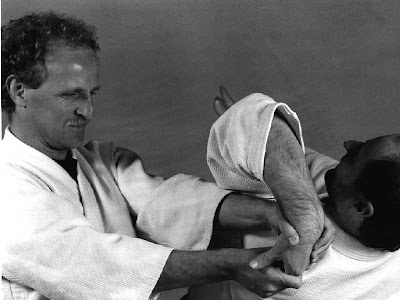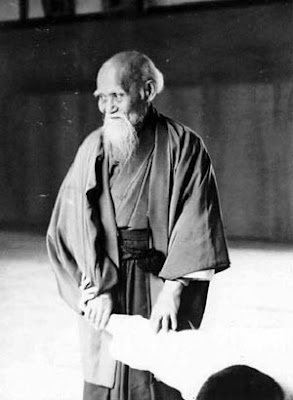This is more on the
viability of aikido for self-defense and for older adults. Perhaps this is more of a philosophical
POV.
.
Superiority, equality, or inferiority
.
What is self-defense? Defense of the self. Not necessarily offense against some other. Sure, sometimes there are people that “need killing,” but that is not self-defense. For example, if you know a given martial art so well, have trained it so long and so rigorously that you know, absolutely KNOW that you are completely superior to some particular enemy, is it self-defense to destroy that enemy? If you know that you absolutely outclass them then it’s not self-defense – it is retribution or punishment or murder or something like that.
.
It is only self-defense when you are immediately afraid for your life or well-being.
.
When are you most reasonably afraid? When you’re surprised in the dark on uncertain footing and outclassed and out-gunned and the enemy knows what is going on and is younger and stronger and faster and bigger and better at what he is doing than you. You are most afraid in a situation of weakness and inferiority and lack of knowledge.
.
Karate, etc… is generally built from an assumption of superiority. All other things being equal, the karateka will use superior technique or training or strength or speed or leverage, etc.. .to prevail.
.
Judo, boxing, even MMA is confined by an extensive ruleset. There are things that you do not train because they are simply against the rules and therefore, you will never have to deal with in the ring. These arts/sports are also based on an assumption of equality – weight classes and rule sets equalize the opponents to showcase their training and/or artistry.
.
Aikido is just a brand name for the jujitsu that all this stuff is based on. As such, there are fewer limiting assumptions. Sure, you don’t want to hurt your partner, so there are training rules, like moving slowly or making more abstract attacks, but that is a different kind of ruleset – one based on safety instead of balanced competition.
.
Everything in aikido is testable and falsifiable through randori (sparring or free play). Not just nice sparring drills or one-steps either – so long as you participate within a framework of decency for safety, anything goes in aikido randori. Any technique may be tried, tested, falsified, rejected, or tested and approved.
.
Our normal practice mode in aikido makes it explicit that once the uke takes one complete attack step in the kata pattern, they may use any foreknowledge, training, or physical attribute (speed, strength, size, etc…) to confound the technique, and if it doesn’t work then something is wrong. You may use any knowledge or advantage to demonstrate a weakness in an aikido technique.
.
Thus, aikido is based on an initial assumption of inferiority or weakness or slowness. We invest in that weakness and slowness by avoiding the necessary use of strength and speed to make things work. As we invest in that state of weakness, we try to figure out how to work it to our salvation. Thus, aikido, by its definition and its nature, is all about self-defense. Aikido is THE art of self defense. Karate, and even sport judo, are not even about self defense in this sense because they predominantly operate from equality or superiority.
.
Now, before you decide to challenge me to a death match for the honor of your system, remember that won’t prove anything. Am I the ultimate proponent of this aiki ideal? No. But I have experienced enough of the aiki-thing to understand that training regularly from a position of weakness and inferiority is more likely to save me in a situation where I am surprised and outclassed than training from a position of advantage or equality.
.



















